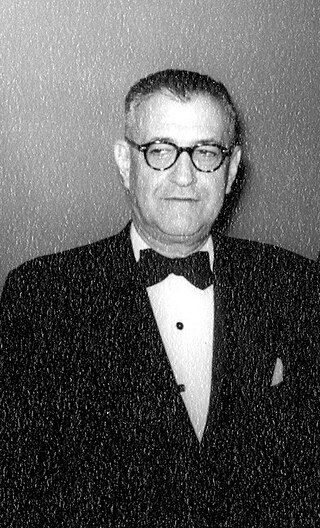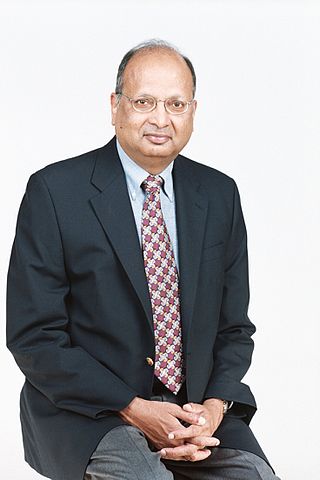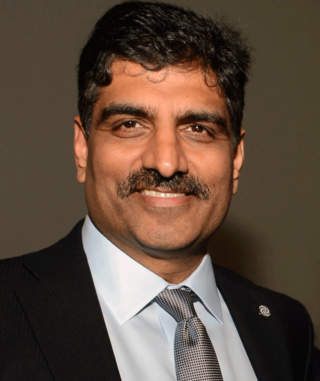
The Institute of Electrical and Electronics Engineers (IEEE) is an American 501(c)(3) professional association for electronics engineering, electrical engineering, and other related disciplines.

Donald Oscar Pederson was an American professor of electrical engineering at the University of California, Berkeley, and one of the designers of SPICE, a simulator for integrated circuits that has been universally used as a teaching tool and in the everyday work of circuits engineers. The IEEE Donald O. Pederson Award in Solid-State Circuits is named in his honor.

The Institute of Radio Engineers (IRE) was a professional organization which existed from 1912 until December 31, 1962. On January 1, 1963, it merged with the American Institute of Electrical Engineers (AIEE) to form the Institute of Electrical and Electronics Engineers (IEEE).
The American Institute of Electrical Engineers (AIEE) was a United States-based organization of electrical engineers that existed from 1884 through 1962. On January 1, 1963, it merged with the Institute of Radio Engineers (IRE) to form the Institute of Electrical and Electronics Engineers (IEEE).

Jun-ichi Nishizawa was a Japanese engineer and inventor. He is known for his electronic inventions since the 1950s, including the PIN diode, static induction transistor, static induction thyristor, SIT/SITh. His inventions contributed to the development of internet technology and the information age.

Anurag Kumar was the Director of the Indian Institute of Science at Bangalore, India from 2014–2020. He is a professor at the Department of Electrical Communication Engineering, and has served as the Chairperson of the Electrical Sciences Division at the Indian Institute of Science, before being appointed as the Director in 2014.

Walter Ransom Gail Baker was an American electrical engineer. He was a vice president of General Electric, and was Director of Engineering for the Radio Manufacturers Association. At the urging of James Lawrence Fly, Chairman of the Federal Communications Commission (FCC), Baker founded the National Television System Committee, or NTSC, in 1940. He served as president of the Institute of Radio Engineers (IRE) in 1947.

Arogyaswami J. Paulraj is an Indian-American electrical engineer, academic. He is a Professor Emeritus in the Dept. of Elect. Engg. at Stanford University.
Jan Aleksander Rajchman was a Polish-American electrical engineer and computer pioneer.

The IEEE Medal of Honor is the highest recognition of the American Institute of Electrical and Electronics Engineers (IEEE). It has been awarded since 1917, and is given to an individual for an exceptional contribution or an extraordinary career in the IEEE fields of interest. The award consists of a gold medal, a bronze replica, a certificate, and an honorarium.
Dr. Leonard F. Fuller was a noted American radio pioneer. In 1919, Fuller earned a PhD degree at the Stanford Department of Electrical Engineering. In World War I, he was part of the antisubmarine group of the National Research Council, and charged with the design and installation of the "high-power transoceanic radio telegraph stations" built by the United States Army and Navy. He held 24 patients for inventions before his death. He spent time as chair of the electrical engineering department at University of California, Berkeley, and then was acting professor of electrical engineering at Stanford University from 1946 until he retired in 1954.
Evangelia Micheli-Tzanakou was a professor of biomedical engineering and the Director of Computational Intelligence Laboratories at Rutgers University. Dr. Micheli-Tzanakou was also a Founding Fellow of the American Institute for Medical and Biological Engineering (AIMBE), a Fellow of the Institute of Electrical and Electronics Engineers (IEEE), and a Fellow of the New Jersey Academy of Medicine. Dr. Micheli-Tzanakou's areas of interest included neural networks, information processing in the brain, image and signal processing applied to biomedicine, telemedicine, mammography, hearing aids and electronic equivalents of neurons. Dr. Micheli-Tzanakou received international attention in 1974 when she established the first Brain to Computer Interface (BCI) using her algorithm ALOPEX. This method was used in the study of Parkinson's disease. The ALOPEX algorithm has also been applied toward signal processing, image processing, and pattern recognition. Dr. Micheli-Tzanakou died on September 24, 2012, after a long fight with cancer.

Patrick Eugene Haggerty was an American engineer and businessman. He was a co-founder and former president and chairman of Texas Instruments, Incorporated (TI). Under his leadership, the company grew from a small Texas oil exploration company into a global leader in the semiconductor industry. During his tenure, TI invested in transistors when their commercial value was still much in question, created the first silicon transistor, the first commercial transistor radio, the first integrated circuit, and helped develop and produce the first single chip microprocessor.
Donald Glen Fink was an American electrical engineer, a pioneer in the development of radio navigation systems and television standards, vice president for research of Philco, president of the Institute of Radio Engineers, General Manager of the IEEE, and an editor of many important publications in electrical engineering.
The Proceedings of the IEEE is a monthly peer-reviewed scientific journal published by the Institute of Electrical and Electronics Engineers (IEEE). The journal focuses on electrical engineering and computer science. According to the Journal Citation Reports, the journal has a 2017 impact factor of 9.107, ranking it sixth in the category "Engineering, Electrical & Electronic." In 2018, it became fifth with an enhanced impact factor of 10.694.
Emmett Finley Carter was an electrical engineer that worked at several companies; most notably, he was in upper management of Sylvania Electric Products and was the director, and later president, of SRI International from 1956 to 1963.
Claud M. Davis was an American engineer, inventor, and employee of the IBM Corporation at Poughkeepsie, New York. He was known for his contributions to the development of the IBM System/360 and the development of air traffic control systems.

Venu Govindaraju is an Indian-American whose research interests are in the fields of document image analysis and biometrics. He presently serves as the Vice President for Research and Economic Development. He is a SUNY Distinguished Professor of Computer Science and Engineering, School of Engineering and Applied Sciences at the University at Buffalo, The State University of New York, Buffalo, NY, USA.
Ranjan Kumar Mallik is an Indian electrical and communications engineer and a professor at the Department of Electrical Engineering of the Indian Institute of Technology, Delhi. He held the Jai Gupta Chair at IIT Delhi from 2007 to 2012 and the Brigadier Bhopinder Singh Chair from 2012 to 2017. He is known for his researches on multiple-input multi-output systems and is an elected fellow of all the three major Indian science academies viz. Indian Academy of Sciences, Indian National Science Academy, and The National Academy of Sciences, India. He is also an elected fellow of The World Academy of Sciences, Indian National Academy of Engineering, and The Institute of Electrical and Electronics Engineers, Inc.
Paul William Coteusis an electrical engineer at IBM's T.J. Watson Research Center in Yorktown Heights, New York.








